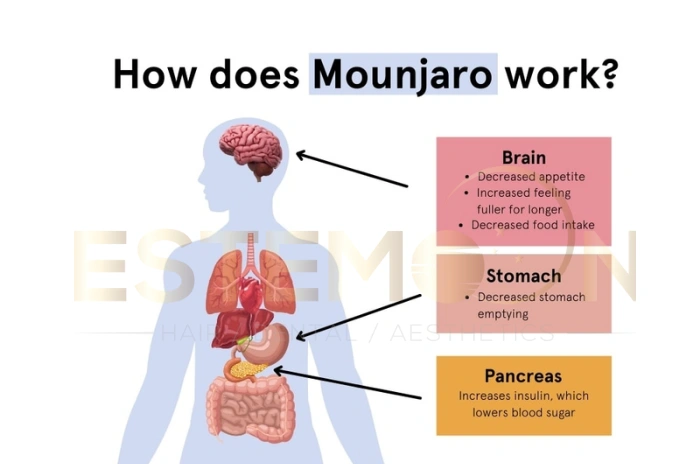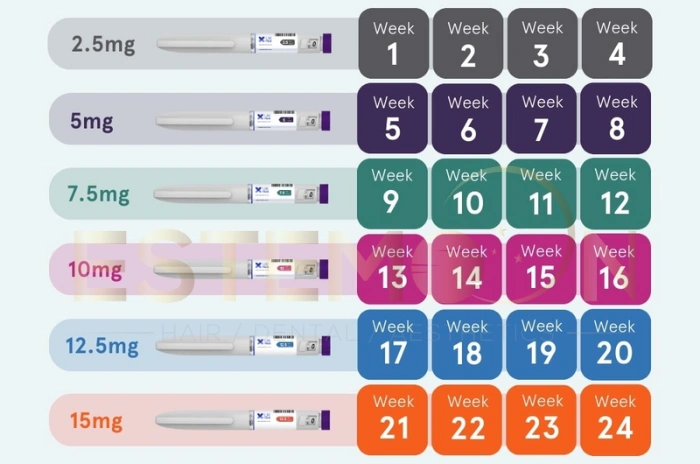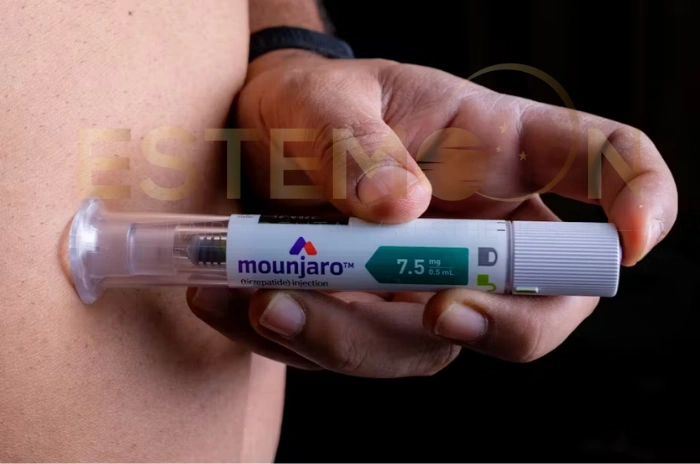Mounjaro (tirzepatide) has emerged as a groundbreaking medication for weight management, showing remarkable results in clinical trials and real-world applications. This FDA-approved treatment originally developed for type 2 diabetes has revolutionized the approach to sustainable weight loss.
Understanding how Mounjaro works for weight loss, its expected timeline, and potential side effects is crucial for anyone considering this treatment. This comprehensive guide explores everything you need to know about Mounjaro weight loss results and how to maximize your success while managing any adverse effects.

Understanding Mounjaro and Its Role in Weight Loss
Mounjaro (tirzepatide) represents a new class of medications called dual glucose-dependent insulinotropic polypeptide (GIP) and glucagon-like peptide-1 (GLP-1) receptor agonists. Unlike traditional weight loss medications, Mounjaro for weight loss works by targeting multiple pathways in the body.
The medication mimics natural hormones that regulate blood sugar and appetite. When administered as a weekly Mounjaro injection, it significantly reduces hunger and increases feelings of fullness, leading to natural calorie reduction without the constant struggle against cravings.
Clinical studies demonstrate that patients using Mounjaro for weight loss can achieve 15-20% body weight reduction over 72 weeks. This substantial weight loss occurs gradually and sustainably, making it easier to maintain long-term results compared to rapid weight loss methods.
The Mounjaro benefits extend beyond weight reduction, including improved blood sugar control, reduced cardiovascular risk factors, and enhanced overall metabolic health. These comprehensive effects make it particularly valuable for individuals with obesity-related health conditions.
How Mounjaro Works to Promote Weight Loss
How Mounjaro works involves a sophisticated mechanism targeting the brain’s appetite control centers. The medication activates GIP and GLP-1 receptors, which slow gastric emptying and promote satiety signals to the brain.
Mounjaro and appetite suppression occurs through several pathways. The medication delays food movement from the stomach to the small intestine, creating prolonged feelings of fullness. Additionally, it reduces food cravings and the psychological drive to eat, particularly for high-calorie foods.
| Mechanism | Effect | Timeline |
|---|---|---|
| GIP/GLP-1 Receptor Activation | Appetite suppression | 1-2 weeks |
| Delayed Gastric Emptying | Prolonged fullness | 2-4 weeks |
| Reduced Food Cravings | Decreased calorie intake | 2-6 weeks |
| Improved Insulin Sensitivity | Better glucose metabolism | 4-8 weeks |
| Hormone Regulation | Normalized hunger signals | 6-12 weeks |
The dual receptor activation sets Mounjaro vs Ozempic apart, as Ozempic only targets GLP-1 receptors. This dual mechanism may explain why Mounjaro results often show superior weight loss compared to single-receptor medications.
Tirzepatide weight loss effects also include improved insulin sensitivity and glucose metabolism. These metabolic improvements contribute to better energy utilization and fat burning, supporting the overall weight loss process.
The medication’s impact on hormone regulation extends to leptin and ghrelin, the primary hunger and satiety hormones. By normalizing these hormone levels, Mounjaro helps restore natural appetite regulation that may have been disrupted by obesity.
What to Expect Week by Week on Mounjaro
Mounjaro Week by Week: First Month
Week 1-2: The Mounjaro starting dose is typically 2.5 mg weekly. During this initial period, many patients notice reduced appetite and earlier satiety during meals. Some experience mild nausea as the body adjusts to the medication.
Week 3-4: Mounjaro results first month often include 3-5 pounds of weight loss. Appetite suppression becomes more pronounced, and food cravings, particularly for sweets and high-fat foods, significantly decrease.
Mounjaro Weekly Guide: Months 2-3
The Mounjaro dosage typically increases to 5 mg at week 5, then to 7.5 mg at week 9 if needed. Mounjaro weight loss timeline shows accelerated results during this period, with many patients losing 8-12 pounds by month 3.
| Time Period | Typical Dosage | Expected Weight Loss | Common Experiences |
|---|---|---|---|
| Week 1-4 | 2.5 mg | 3-5 lbs | Reduced appetite, mild nausea |
| Week 5-8 | 5.0 mg | 6-10 lbs | Decreased cravings, improved energy |
| Week 9-12 | 7.5 mg | 8-15 lbs | Significant appetite control |
| Week 13-24 | 10-15 mg | 15-25 lbs | Steady weight loss, lifestyle changes |
| Month 6+ | Maintenance dose | 20-30+ lbs | Long-term weight management |
Energy levels often improve as metabolic changes take effect. Patients report feeling more motivated to engage in physical activity, which enhances the overall weight loss process.
Mounjaro Weight Loss Expectations: Months 4-6
Mounjaro before and after comparisons become most dramatic during this period. The Mounjaro dosage may reach 10-15 mg weekly, depending on individual response and tolerance.
Weight loss typically reaches 10-15% of initial body weight by month 6. Beyond the scale, patients notice improvements in energy, mobility, sleep quality, and overall confidence.

Common Mounjaro Side Effects and How to Manage Them
Gastrointestinal Side Effects
The most common Mounjaro side effects affect the digestive system. Nausea occurs in approximately 12-18% of patients, typically during the first few weeks or after dose increases.
| Side Effect | Frequency | Severity | Management Strategy |
|---|---|---|---|
| Nausea | 12-18% | Mild to Moderate | Small frequent meals, avoid high-fat foods |
| Diarrhea | 8-12% | Mild | Stay hydrated, probiotics, fiber adjustment |
| Vomiting | 5-8% | Mild to Moderate | Take injection at bedtime, bland foods |
| Constipation | 6-10% | Mild | Increase fiber and water intake |
| Decreased Appetite | 90%+ | Beneficial | Monitor nutrition, ensure adequate protein |
| Injection Site Reaction | 3-5% | Mild | Rotate injection sites, apply ice if needed |
Managing Mounjaro side effects for nausea includes eating smaller, more frequent meals and avoiding high-fat foods. Staying hydrated and taking the injection at bedtime can also help minimize morning nausea.
Diarrhea and constipation may alternate as the digestive system adjusts. Maintaining adequate fiber intake and staying hydrated helps regulate bowel movements naturally.
Injection Site Reactions
The Mounjaro injection may cause mild redness, swelling, or itching at the injection site. Rotating injection locations between the thigh, abdomen, and upper arm helps prevent these reactions.
Most injection site reactions resolve within 24-48 hours and become less common as patients become accustomed to the medication.
Fatigue and Headaches
Some patients experience temporary fatigue or headaches, particularly during the first month. These symptoms often resolve as the body adapts to improved metabolic function and dietary changes.
Maintaining consistent sleep schedules and staying adequately hydrated can help minimize these side effects.
Tips for Maximizing Your Weight Loss Results with Mounjaro
Optimizing Your Diet
Maximizing Mounjaro results requires combining the medication with healthy lifestyle choices. Focus on protein-rich foods to maintain muscle mass during weight loss and enhance satiety effects.
| Food Category | Recommended | Avoid/Limit | Benefits |
|---|---|---|---|
| Protein | Lean meats, fish, eggs, legumes | Processed meats | Maintains muscle mass, enhances satiety |
| Vegetables | Non-starchy vegetables, leafy greens | Fried vegetables | High fiber, low calories, nutrients |
| Carbohydrates | Whole grains, quinoa, sweet potatoes | Refined sugars, white bread | Sustained energy, better glucose control |
| Fats | Avocado, nuts, olive oil | Trans fats, fried foods | Essential nutrients, hormone production |
| Beverages | Water, herbal teas | Sugary drinks, alcohol | Hydration, reduced empty calories |
Eliminate ultra-processed foods and sugary beverages, as these can interfere with the medication’s appetite-regulating effects. Instead, emphasize whole foods, vegetables, lean proteins, and complex carbohydrates.
Exercise and Physical Activity
While Mounjaro significantly reduces appetite, incorporating regular physical activity accelerates weight loss and improves overall health outcomes. Start with low-impact activities like walking and gradually increase intensity as fitness improves.
Resistance training helps preserve muscle mass during weight loss, maintaining metabolic rate and improving body composition beyond what the scale reflects.
Tracking Progress and Accountability
Keep detailed records of weight, measurements, energy levels, and side effects. This information helps healthcare providers optimize Mounjaro dosage and identify patterns that support success.
Consider working with a registered dietitian or weight loss coach to develop sustainable eating habits that complement the medication’s effects.
Comparing Mounjaro to Other Weight Loss Treatments
Mounjaro vs Ozempic Weight Loss
Mounjaro vs Ozempic comparisons show that Mounjaro typically produces greater weight loss due to its dual receptor mechanism. While Ozempic targets only GLP-1 receptors, Mounjaro’s dual GIP/GLP-1 action often results in superior appetite suppression and metabolic benefits.
| Comparison Factor | Mounjaro | Ozempic | Wegovy |
|---|---|---|---|
| Mechanism | Dual GIP/GLP-1 | GLP-1 only | GLP-1 only |
| Average Weight Loss | 15-22% | 10-15% | 12-18% |
| Injection Frequency | Weekly | Weekly | Weekly |
| Starting Dose | 2.5 mg | 0.25 mg | 0.25 mg |
| Maximum Dose | 15 mg | 2 mg | 2.4 mg |
| FDA Approved for Weight Loss | Yes | No (diabetes only) | Yes |
| Mounjaro cost | $900-1200/month | $800-1000/month | $1000-1300/month |
Mounjaro cost may be higher than Ozempic, but many patients find the enhanced results justify the investment. Mounjaro insurance coverage varies by provider, and Mounjaro savings card programs may help reduce out-of-pocket expenses.
Traditional Weight Loss Methods
Compared to diet and exercise alone, Mounjaro for weight loss provides biological support that makes sustainable weight loss more achievable. While lifestyle modifications remain important, the medication addresses the hormonal and neurological aspects of appetite regulation that often sabotage long-term success.
Surgical Options
Mounjaro offers a non-surgical alternative to bariatric procedures, with comparable weight loss results for many patients. The medication provides flexibility that surgery cannot, allowing for dose adjustments and discontinuation if needed.
Mounjaro patient experience often includes fewer complications and faster recovery compared to surgical interventions, making it an attractive option for appropriate candidates.
Mounjaro and Diabetes Management
Mounjaro and diabetes management go hand-in-hand, as the medication was originally developed for type 2 diabetes treatment. The weight loss effects provide additional benefits for diabetic patients, often leading to improved blood sugar control and reduced medication requirements.
Mounjaro prescribing information indicates significant improvements in HbA1c levels, with many patients achieving target blood sugar ranges while simultaneously losing weight.
For non-diabetic patients using Mounjaro for weight loss, the medication’s glucose-regulating effects may help prevent the development of type 2 diabetes, providing long-term metabolic health benefits.
FAQs About Mounjaro Dosage Chart for Weight Loss Results
How does Mounjaro work for weight loss?
Mounjaro works by activating GIP and GLP-1 receptors, which slow gastric emptying, reduce appetite, and promote feelings of fullness, leading to natural calorie reduction and sustainable weight loss.
What is a typical Mounjaro weight loss timeline?
Mounjaro weight loss timeline typically shows 3-5 pounds lost in the first month, 8-12 pounds by month 3, and 15-20% total body weight reduction over 12-18 months with consistent use.
What are the common side effects of Mounjaro?
Common Mounjaro side effects include nausea, diarrhea, decreased appetite, vomiting, constipation, and injection site reactions, with most symptoms being mild to moderate and improving over time.
How does Mounjaro compare to other treatments?
Mounjaro vs Ozempic and other treatments typically shows superior weight loss results due to its dual receptor mechanism, often producing 15-20% body weight reduction compared to 10-15% with single-receptor medications.
Follow us on social media for updates, tips, and patient success stories:




